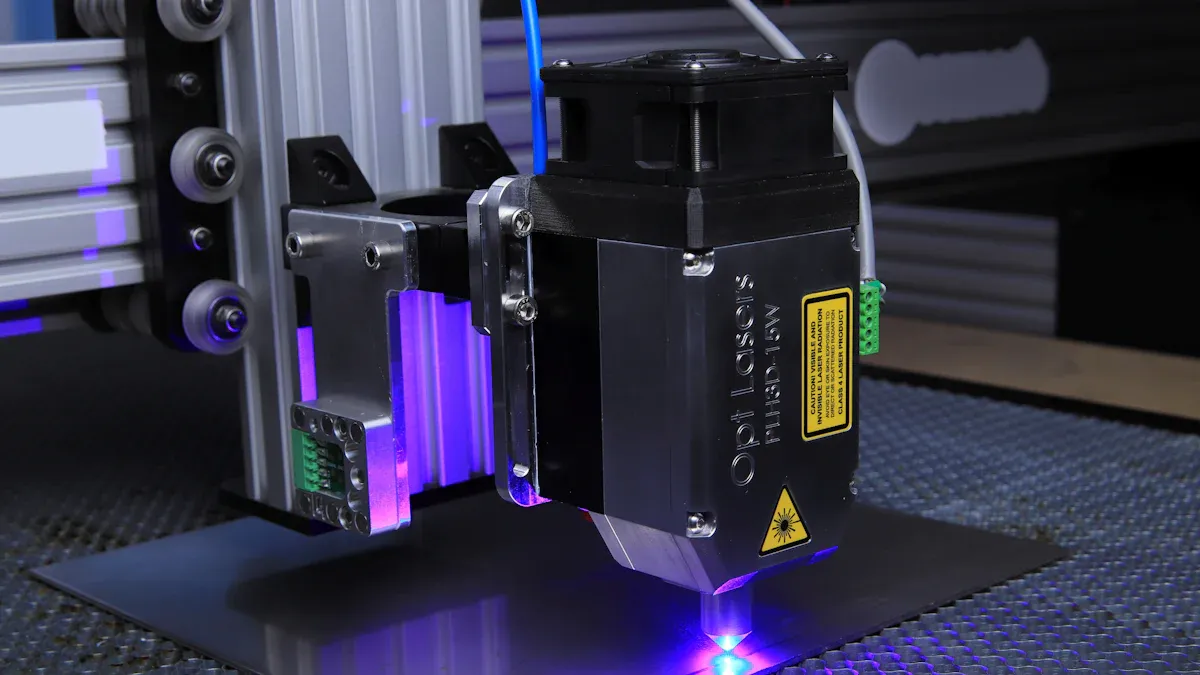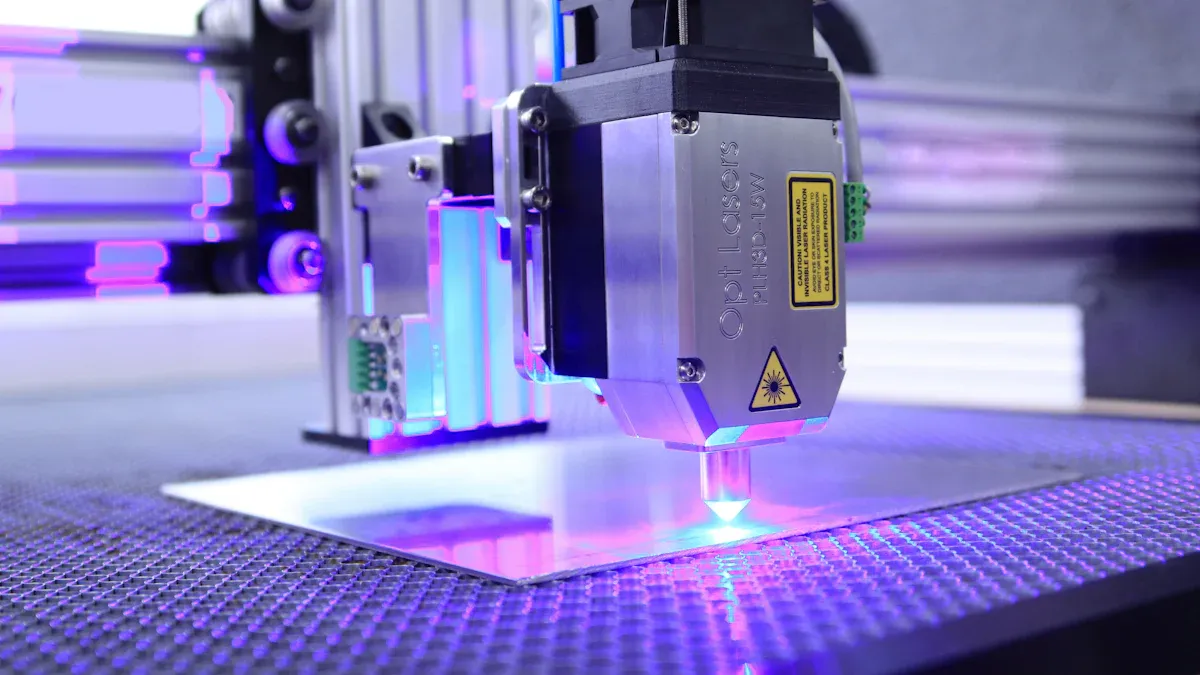NiTi Laser Processing Tips You Need Today

NiTi shape memory alloy requires careful handling during laser work, especially when utilizing NiTi laser processing techniques. By improving these laser methods, you can achieve better results more quickly. For instance, energy levels such as 74.04 J/mm³, 148 J/mm³, and 222 J/mm³ influence wall thickness and heat changes. This illustrates how laser power and speed affect heat and structure. Additionally, the strength and flexibility of NiTi can vary depending on whether it is new or aged. These factors highlight the importance of adjusting every step in the NiTi laser processing techniques for optimal results. With the right approach, you can significantly enhance NiTi processing.
Key Takeaways
Pick pure materials for NiTi laser work. This gives better results and keeps the material strong.
Clean surfaces well before using the laser. A clean surface stops mistakes and makes the product better.
Adjust laser power and speed wisely. The right balance keeps the material strong and cuts well.
Use tools to watch the process in real-time. These tools check heat and change settings to stop overheating.
Treat NiTi parts after cutting with stress relief and polishing. This makes them last longer and look nicer.
Getting Ready for NiTi Laser Processing
Picking Materials for NiTi and Ti-6Al-4V
Choosing the right material is very important. For NiTi, use gas-atomized powder with the right particle size. High-purity materials made in an argon atmosphere keep their properties intact. Ti-6Al-4V is strong and resists rust, making it durable. These features make it great for tough jobs. Set the layer thickness to 25 µm for better results. Picking good materials and preparing them well makes the process easier.
Cleaning and Getting the Surface Ready
Cleaning the surface is key for good results. Dirt or oil can mess up the laser's work. Use a degreaser to clean off oils and grime. For NiTi and Ti-6Al-4V, remove oxidation or other residues. A clean surface helps the laser work better and avoids defects. This step also keeps heat zones even, making the material uniform.
Keeping Things Stable and Aligned
Stability is needed for accurate laser work. Hold the material steady with a strong fixture to stop movement. Align the laser beam correctly for the best angle and position. For NiTi and Ti-6Al-4V, stability lowers mistakes and uneven results. Use alignment tools to check the setup before starting. A stable system improves the final product's quality.
Optimizing NiTi Laser Processing Techniques
Balancing Laser Power and Speed
Getting the right mix of laser power and speed is key. More power cuts faster but may lose accuracy. Faster scanning lowers heat but can weaken material strength. You need to weigh these choices to find the best settings.
Here’s how power and speed affect materials:
Parameter | Effect on Strength | Effect on Flexibility |
|---|---|---|
Laser Power | Less strength | More flexibility |
Scanning Speed | Less strength | More flexibility |
This table shows why balancing these factors is important for good results.
Adjusting Pulse Duration to Minimize Heat-Affected Zones
Pulse duration controls how much heat reaches the material. Shorter pulses keep the material strong by reducing heat damage. This is crucial for NiTi, as too much heat changes its behavior. Tests show that lower energy and steady speed help. Less energy lowers holes in the material, and steady speed keeps nickel levels stable.
By adjusting pulse duration and other settings, you can get better and more reliable results.
Managing Beam Focus and Spot Size for Precision
Precision depends on focusing the laser beam well. A focused beam puts energy exactly where it’s needed. Smooth surfaces with low absorption work better with focused beams. Studies show that small focus shifts improve cutting accuracy.
To keep precision high, check your laser system often. Adjust the beam focus regularly for the best results. Managing these details improves the quality of your work.
Watching the Process for Steady Results
Tools to Watch NiTi in Real-Time
Real-time tools keep NiTi laser work steady and accurate. These tools check temperatures during the process, which is key for small items like wires. Pyrometers track heat instantly, stopping overheating and damage. This helps keep NiTi strong, as too much heat can harm it by causing nickel to evaporate.
Advanced systems also spot defects in specific areas. They measure laser power and beam size to keep things steady. Closed-loop systems, like the LENS system, adjust settings automatically using live feedback. These tools make the process smoother, cut downtime, and boost efficiency.
Spotting and Shrinking Heat-Affected Zones
Heat-affected zones (HAZ) can weaken NiTi. You can shrink these zones by tweaking laser settings. For example, more laser power raises heat but slows cooling, making HAZ bigger. Faster scanning lowers heat and speeds cooling, shrinking HAZ.
Laser Setting Change | Peak Heat Effect | Cooling Effect | HAZ Size Effect |
|---|---|---|---|
More Power, Same Speed | Heat Increases | Cooling Slows | HAZ Grows |
Faster Speed, Same Power | Heat Decreases | Cooling Speeds | HAZ Shrinks |
Knowing these effects helps you adjust for better results. Watching HAZ often keeps NiTi strong and improves quality.
Keeping Ti-6Al-4V Even and Reliable
Even Ti-6Al-4V parts need good powder and settings. Fresh powders with even sizes and round shapes work best. Reused powders meet standards but may vary slightly in strength due to uneven sizes and shapes.
Powder Type | Size Range | Shape | α′ Lath Thickness (µm) | Dislocation Density (m−2) |
|---|---|---|---|---|
Fresh | Narrow | Round | 0.20 ± 0.01 | 9.38 × 10^15 |
Reused | Wider | Uneven | 0.27 ± 0.03 | N/A |
Spatter | Widest | Clumped | 0.20 ± 0.01 | 1.72 × 10^15 |
Handling powders carefully keeps parts even. Advanced tools also help by checking layer thickness and spotting flaws. These steps make sure Ti-6Al-4V parts are strong and meet standards.
Post-Processing for Quality Assurance

Checking Microstructural Changes in NiTi
Knowing how lasers change NiTi's structure is important. These changes affect its strength and flexibility. Laser energy levels can change grain size and shape. For example:
More laser energy makes smaller grains and clear patterns in melted areas.
Tiny grains and different patterns form with higher energy use.
These changes impact how strong and flexible NiTi becomes. Smaller grains make it stronger and more flexible. This is great for jobs needing both strength and flexibility. Regular checks help keep quality steady.
Reducing Stress for Better Durability
Lowering stress is key after laser work on NiTi. Lasers can leave stress that weakens the material. Heat treatment helps remove this stress and makes NiTi stronger and more flexible. For NiTi, heating at set temperatures brings back its shape memory ability. This also makes it last longer under repeated use. Using stress-relief steps improves both strength and flexibility, making the final product better.
Cleaning and Polishing for a Smooth Finish
Finishing makes sure NiTi parts meet quality needs. Cleaning removes leftover dirt from laser work. Polishing makes surfaces smooth and shiny. Smooth surfaces lower friction and work better in tough jobs. Ultrasonic cleaning removes dirt well. Polishing methods like electropolishing or mechanical polishing give a shiny finish. These steps improve how the material looks and works, making it stronger and more durable.
Advanced Optimization Techniques for NiTi Laser Processing
Using Simulation Software for Better Planning
Simulation tools help plan laser processes more effectively. They predict how NiTi reacts under certain conditions. For example, machine learning tools like ANNs can forecast material changes. These systems study data to predict results from process settings. This helps you adjust settings before starting, saving time and materials. With simulation software, you can improve the process and get steady results.
Automation and Feedback Loops for Accuracy
Automation and feedback loops make laser systems more accurate. They watch the process live and adjust settings automatically. Closed-loop systems control laser power and speed for steady quality. Automation also boosts production, lowers costs, and improves bonds.
Improvement Type | Benefit |
|---|---|
Manufacturing Yields | Automation raises production success rates. |
Component Costs | Costs drop with better control and setup. |
Bond Quality | Stronger bonds come from precise measurements. |
Adding automation makes the process smoother and reduces mistakes.
Using Statistics to Improve Settings
Statistical methods help find the best laser settings. DOE tests many variables at once, like power and speed. This finds the best mix for strong and flexible materials. Statistics also show how settings affect material properties. Using these methods ensures better quality and efficiency.
Improving NiTi laser processing needs care at every stage. Begin with preparation by picking good materials and cleaning surfaces well. Change laser settings like power, speed, and pulse time for accuracy. This also helps reduce heat damage. Use tools to watch the process live and keep it steady. Afterward, steps like stress removal and polishing make parts stronger and look better.
Tip: Test changes on small pieces first. This way, you can improve your methods without wasting bigger materials.
Using these tips, you can get better results and make NiTi laser processing faster and more effective.
FAQ
How should you clean NiTi before laser work?
Use a degreaser to clean off oils and dirt. For rust or residues, try a gentle scrub or cleaner. A clean surface helps the laser work better and avoids mistakes. Always dry the material completely before starting.
How do you make heat-affected zones smaller?
Change the laser's power and speed to lower heat. Shorter pulses keep heat away from the material. Scanning faster cools it down quickly. Watching the process live helps keep results steady.
Why does alignment matter in NiTi laser work?
Good alignment makes sure the laser hits the right spot. This avoids mistakes and uneven results. Use tools to check alignment before starting. A steady setup makes the final product better.
Can Ti-6Al-4V powders be reused?
Yes, but reused powders might not be as good. Fresh powders are more even in size and shape. Reused powders can slightly lower strength. Always check and clean reused powders to keep quality high.
What tools watch NiTi laser work live?
Tools like pyrometers and closed-loop systems track heat and settings. They stop overheating and adjust settings automatically. These tools make work more accurate and save time while keeping quality steady.
See Also
Strategies for Tackling Nickel-Titanium Alloy Laser Micromachining Issues
Latest Innovations in Nickel-Titanium Tube Laser Cutting Methods
Essential Information About AccuPath NiTi Tubes You Should Have
Comprehensive Overview of Nitinol Components and Production Methods
Detailed Instructions for Creating Nitinol Microtubing in Neurovascular Uses

